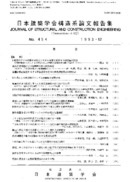402 巻
選択された号の論文の21件中1~21を表示しています
- |<
- <
- 1
- >
- >|
-
原稿種別: 表紙
1989 年402 巻 p. Cover1-
発行日: 1989/08/30
公開日: 2017/12/25
PDF形式でダウンロード (61K) -
原稿種別: 表紙
1989 年402 巻 p. Cover2-
発行日: 1989/08/30
公開日: 2017/12/25
PDF形式でダウンロード (61K) -
原稿種別: 付録等
1989 年402 巻 p. App1-
発行日: 1989/08/30
公開日: 2017/12/25
PDF形式でダウンロード (131K) -
原稿種別: 目次
1989 年402 巻 p. Toc1-
発行日: 1989/08/30
公開日: 2017/12/25
PDF形式でダウンロード (62K) -
原稿種別: 付録等
1989 年402 巻 p. App2-
発行日: 1989/08/30
公開日: 2017/12/25
PDF形式でダウンロード (50K) -
原稿種別: 付録等
1989 年402 巻 p. App3-
発行日: 1989/08/30
公開日: 2017/12/25
PDF形式でダウンロード (50K) -
原稿種別: 本文
1989 年402 巻 p. 1-9
発行日: 1989/08/30
公開日: 2017/12/25
PDF形式でダウンロード (957K) -
原稿種別: 本文
1989 年402 巻 p. 11-19
発行日: 1989/08/30
公開日: 2017/12/25
PDF形式でダウンロード (889K) -
原稿種別: 本文
1989 年402 巻 p. 21-25
発行日: 1989/08/30
公開日: 2017/12/25
PDF形式でダウンロード (469K) -
原稿種別: 本文
1989 年402 巻 p. 27-36
発行日: 1989/08/30
公開日: 2017/12/25
PDF形式でダウンロード (1655K) -
原稿種別: 本文
1989 年402 巻 p. 37-46
発行日: 1989/08/30
公開日: 2017/12/25
PDF形式でダウンロード (975K) -
原稿種別: 本文
1989 年402 巻 p. 47-59
発行日: 1989/08/30
公開日: 2017/12/25
PDF形式でダウンロード (1227K) -
原稿種別: 本文
1989 年402 巻 p. 61-70
発行日: 1989/08/30
公開日: 2017/12/25
PDF形式でダウンロード (951K) -
原稿種別: 本文
1989 年402 巻 p. 71-78
発行日: 1989/08/30
公開日: 2017/12/25
PDF形式でダウンロード (693K) -
原稿種別: 本文
1989 年402 巻 p. 79-87
発行日: 1989/08/30
公開日: 2017/12/25
PDF形式でダウンロード (838K) -
原稿種別: 本文
1989 年402 巻 p. 89-99
発行日: 1989/08/30
公開日: 2017/12/25
PDF形式でダウンロード (1312K) -
原稿種別: 本文
1989 年402 巻 p. 101-109
発行日: 1989/08/30
公開日: 2017/12/25
PDF形式でダウンロード (1049K) -
原稿種別: 本文
1989 年402 巻 p. 111-120
発行日: 1989/08/30
公開日: 2017/12/25
PDF形式でダウンロード (1022K) -
原稿種別: 本文
1989 年402 巻 p. 121-131
発行日: 1989/08/30
公開日: 2017/12/25
PDF形式でダウンロード (1206K) -
原稿種別: 付録等
1989 年402 巻 p. App4-
発行日: 1989/08/30
公開日: 2017/12/25
PDF形式でダウンロード (57K) -
原稿種別: 表紙
1989 年402 巻 p. Cover3-
発行日: 1989/08/30
公開日: 2017/12/25
PDF形式でダウンロード (69K)
- |<
- <
- 1
- >
- >|
